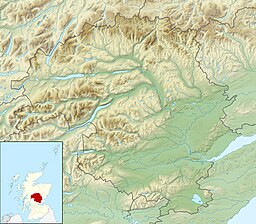Loch Tay
| Loch Tay | |
|---|---|
 Loch Tay at Kenmore in spring | |
| Location | Perthshire, Scotland |
| Coordinates | 56°30′56″N 4°08′46″W / 56.51556°N 4.14611°W |
| Lake type | Loch |
| Primary inflows | Dochart, Lochay |
| Catchment area | 232 sq mi (600 km2)[1] |
| Basin countries | United Kingdom |
| Max. length | 14.55 mi (23.42 km)[1] |
| Max. width | 0.7 mi (1.1 km)[1] |
| Surface area | 10.19 sq mi (26.4 km2)[1] |
| Average depth | 60.66 m (199.0 ft)[1] |
| Max. depth | 154.8 m (508 ft)[1] |
| Water volume | 1.6 km3 (0.38 cu mi) |
| Shore length1 | 3 km (1.9 mi) |
| Surface elevation | 102 m (335 ft) |
| Islands | 7 |
| Settlements | Killin, Kenmore, Lawers |
| 1 Shore length is not a well-defined measure. | |
Loch Tay (Scottish Gaelic: Loch Tatha) is a freshwater loch in the central highlands of Scotland, in the Perth and Kinross and Stirling council areas. The watershed of Loch Tay traditionally formed the historic province of Breadalbane.
It is a long, narrow loch of around 14.55 miles (23.42 km) long, and typically around 1 to 1.5 miles (1.6 to 2.4 km) wide, following the line of the strath from the south west to north east. It is the sixth-largest loch in Scotland by area and over 150 metres (490 ft) deep at its deepest.
Ben Lawers on its north shore is, at 1,214 metres (3,983 ft), the tenth-highest mountain in the British Isles, and is the highest peak in a group of seven munros.

Killin at the head of the loch, and Kenmore at the outflow of the River Tay, are the main settlements on the lochside today. The smaller settlements of Acharn, Ardeonaig and Ardtalnaig are located on the south side of the loch whilst Fearnan and Lawers are on the north side. The loch is fed by the rivers Dochart and Lochay at its head and numerous smaller streams.
The loch is a popular spot for salmon fishing, and many of its surroundings feature in the traditional Scottish 'Loch Tay Boat Song' (Scottish Gaelic, Iorram Loch Tatha). This is a very sad song in which the protagonist muses on unrequited love for a red-haired woman (a Nighean ruadh) whilst rowing at the end of a working day. It has been recorded by Liam Clancy and The Corries amongst others.
Loch Tay railway station was on the Killin Railway. It is now closed.
In the Iron Age, some of the Celtic people of the area lived on defensible, artificial islands in the loch, called crannogs. They are thought to have originated before 2000 BCE, though they continued to be built and used as dwellings and refuges into the Middle Ages. Crannogs (also found elsewhere in Scotland, Ireland, and Wales) not only afforded excellent protection from unruly neighbours but also from the more dangerous wild animals (wolves, bears, boars, and lynxes) that were once common in the British Isles. More than 20 crannogs (most now submerged) have been identified in Loch Tay. An example has been reconstructed on the south side of the loch at the Scottish Crannog Centre.
References
External links
- Killin.info community website, guides, photos, media, news.
- YouTube.com video of Killin area featuring Loch Tay.
- The Scottish Crannog Centre
- some facts about Loch Tay and its history

